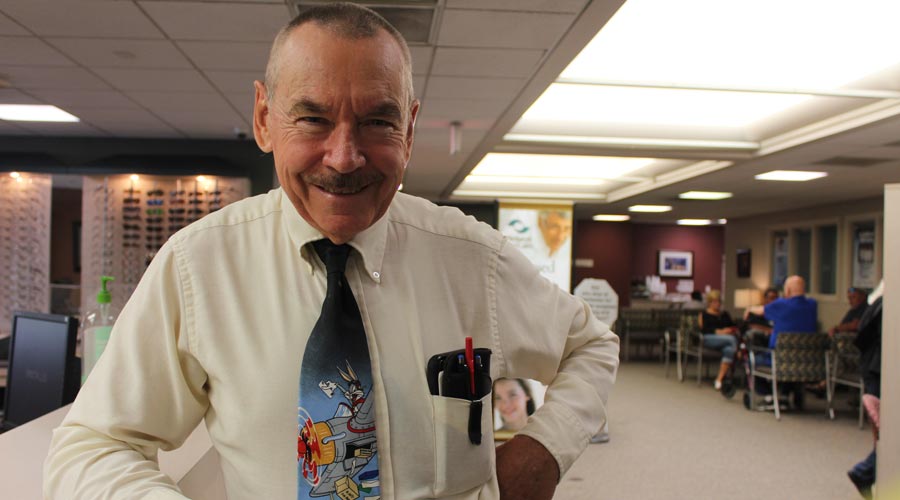
David Hibler, Sr., at Dr. Michael Feilmeier's office.
Photo courtesy of Thomas Curry: Thomas Curry Photography
Sometimes a medical eye exam can save a life. David Hibler, Sr., went to ophthalmologist Michael Feilmeier, MD, because he had trouble with his vision. Within minutes, he learned he could suffer a major stroke at any moment.
The news was a shock to Hibler. He’s a fit and active 73-year-old who runs a nonprofit in Omaha, Neb., Benson Plant Rescue/Community Produce Rescue, Inc. It’s a physically demanding job, rescuing surplus plants from gardeners to give to community gardens and rescuing thousands of pounds of food from the back of grocery stores each week to distribute to nonprofits and people in need.
So, when he suddenly developed a blind spot in his left eye, as he drove down the highway, focused on his work, he thought nothing of it. His vision snapped back as suddenly as it disappeared. Maybe it was a seed husk that lodged in his eye, he thought. But then, it happened again a week later.
"This time, the top left field of vision was a bright white sheet," Hibler explained. "But the top right and some of the bottom right was a swirling mass of little-colored squares of vision floating around in random fashion. Over the course of the next few minutes that seemed like hours, the little squares slowly arranged themselves like a jig-saw puzzle and vision gradually returned to normal."
When it happed a third time, he knew it was time to call the doctor. He remembered seeing an ad for the American Academy of Ophthalmology’s EyeCare America® program. It’s a program that helps eligible seniors who haven’t had a medical eye exam in three or more years. The program connected him to Dr. Feilmeier.
Rescuer is Rescued
It turned out that his eyesight was normal. But when Dr. Feilmeier dilated his pupil to look into the back of his eye, he immediately saw troubling signs of a blood clot. A referral for ultrasound imaging was arranged for the following morning.

Hibler standing in front of Benson Plant Rescue, a nonprofit organization he's run for many years.
The test confirmed Dr. Feilmeier’s diagnosis. A blood clot was blocking 98 percent of Hibler's left carotid artery. The carotid arteries are two large blood vessels that supply blood to the brain. His temporary vision loss was caused by bits of the clot breaking off, and traveling to smaller blood vessels in his eye, blocking the blood supply to his retina. This blockage of blood flow is called a transient ischemic attack (TIA). TIAs usually last a few minutes. Hibler would need surgery to remove the blood clot from his carotid artery.
"When there is no blood supply to the retina, it can lead to blindness," Dr. Feilmeier said. "But even more of a concern was if a bigger chunk of the clot broke off and shut off the oxygen supply to his brain. That could mean death. It could cause a fatal stroke. I see patients in my office about once a month who show signs of a blood clot. Usually, an ultrasound doesn’t find anything, but sometimes, it can save a life."
That’s why routine eye exams are so important, Dr. Feilmeier explained. “We can tell a lot about your overall health just by looking into your eyes. They give us insight into other health problems, such as diabetes and high blood pressure. We’re not just looking for eye diseases like cataracts and glaucoma.”
The American Academy of Ophthalmology recommends annual eye exams for everyone aged 65 and older to look for signs of age-related eye diseases such as cataracts, age-related macular degeneration and glaucoma. By age 65, one in three Americans has some form of vision-limiting eye disease.
Thankful for EyeCare America
While Hibler was still groggy from the surgery to remove the clot, his surgeon came to his bedside to tell him he had just dodged The Big One. Dr. Feilmeier had rescued the plant and food rescuer from imminent death. The gravity of his experience was not lost on him.
“Since it doesn't cause permanent damage, it might seem like no big deal. But ignoring it is a big mistake. – David Hibler, Sr.
"Don’t ignore TIAs. They are warning signs of a stroke," Hibler said.
In addition to temporary blindness, a TIA can cause:
- Double vision
- Weakness, numbness or paralysis in your face, arm or leg, typically on one side of your body
- Slurred or garbled speech or difficulty understanding others
- Dizziness or loss of balance or coordination
- Sudden, severe headache with no known cause
"Since it doesn't cause permanent damage, it might seem like no big deal," Hibler said. "But ignoring it is a big mistake. These warning signs need to be addressed immediately."
His experience has also turned him into an advocate for EyeCare America.
"It’s a resource that could potentially save your life," he said.